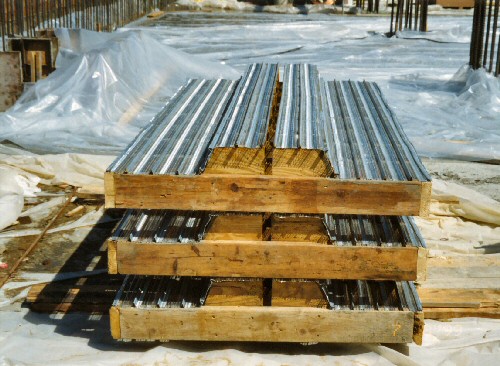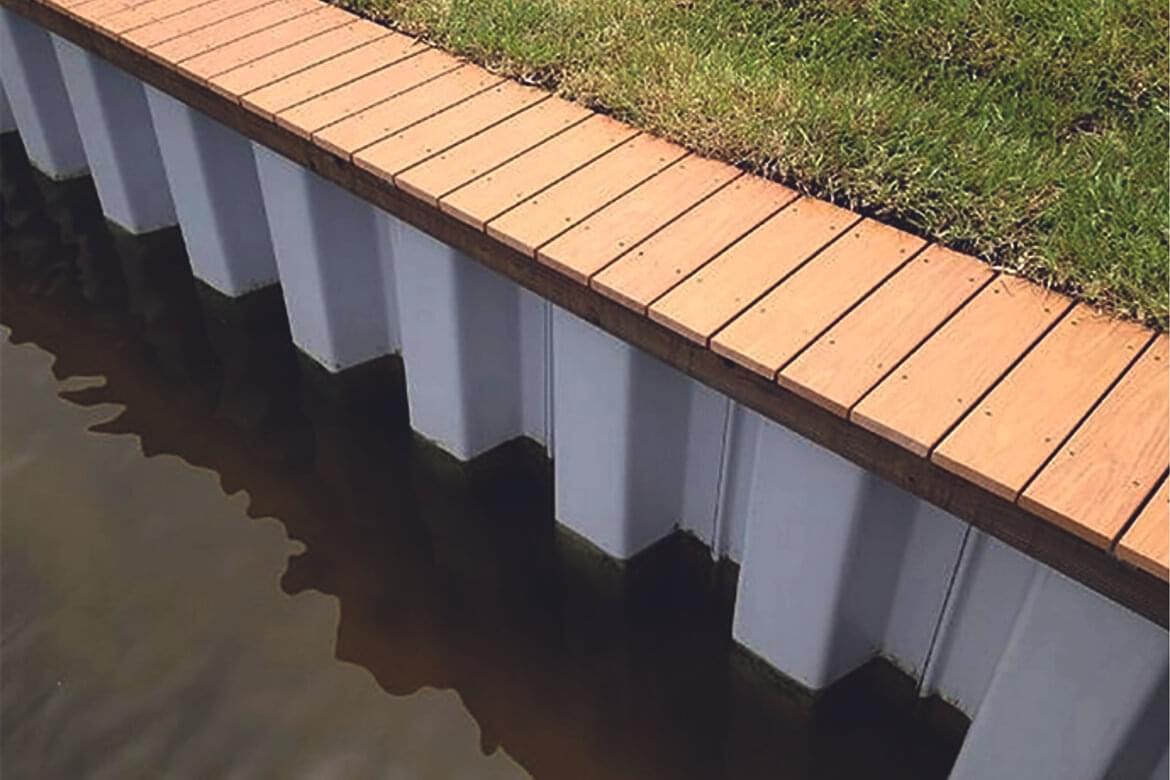Exploring the Numerous Uses Bulkhead Frameworks in Modern Design
Bulkhead frameworks play a significant role in modern design, serving both visual and practical purposes. They can define rooms, boost storage remedies, and improve lighting. In commercial setups, they serve as centerpieces that show brand name identification - Bulkhead on Lake Livingston. In addition, their integration typically supports audio administration and sustainable techniques. Understanding the complete extent of their applications discloses much concerning modern design trends and individual experience. What ingenious uses of bulkheads might arise in the future?
Specifying Bulkhead Frameworks
Bulkhead structures play a vital function in modern design, working as necessary components in various building styles. These structures are generally defined as raised ceilings or platforms, commonly utilized to conceal mechanical systems, wiring, or plumbing. Bulkheads can be found in both household and industrial setups, where they give a smooth blend of functionality and aesthetic appeals. Their layout can integrate illumination fixtures and various other attractive aspects, boosting the general visual charm of a room.
Commonly built from products such as timber, drywall, or metal, bulkheads can be customized to fit the building style and needs of the building (Bulkhead on Lake Livingston). They serve not just to hide unattractive infrastructure but additionally to develop defined zones within open areas. By taking care of the circulation of a space, bulkheads contribute to the spatial company, making them a substantial aspect of contemporary building practice. Their definition encapsulates both useful and aesthetic dimensions.
Useful Applications in Residential Style
Bulkhead frameworks play a vital role in property layout by helping with room optimization approaches that take full advantage of functional areas. They add visual design components that enhance the aesthetic charm of living spaces. On top of that, these structures supply essential structural support remedies, ensuring the integrity and safety of the home.
Area Optimization Strategies
As contemporary domestic designs significantly focus on reliable use area, ingenious methods arise to make the most of performance without compromising visual appeals. One noticeable technique includes the integration of bulkhead frameworks, which can delineate areas while giving vital storage remedies. These frameworks can be employed to produce vertical storage devices that boost both company and access. Furthermore, multi-functional furniture, such as convertible sofas and collapsible tables, complements bulkhead designs, permitting areas to adjust to varying needs. Open up layout better enhance spatial flow, encouraging adaptability being used. Including integrated shelving and recessed illumination within bulkheads likewise adds to a streamlined environment, making certain that every square inch of space is used successfully and sympathetically within the general layout.
Visual Style Elements

Architectural Assistance Solutions
In modern-day residential design, an efficient architectural assistance solution is crucial for keeping the honesty of spaces while optimizing layout and functionality. Bulkhead structures play a substantial duty in this scenario, working as both support and dividing components. They can hide mechanical systems, such as plumbing and electrical wiring, while supplying reinforcement to the ceiling and floor systems. By purposefully positioning bulkheads, engineers can develop specified areas within open layout, boosting functionality without jeopardizing architectural security. Furthermore, these frameworks can accommodate lighting fixtures, adding to both aesthetic appeals and usefulness. To summarize, bulkhead structures are essential in domestic design, supplying functional assistance remedies that enhance both the functionality and visual appeal of living rooms.
Enhancing Appearances in Business Areas
When business rooms accept innovative bulkhead frameworks, they not only specify physical borders but also substantially boost the general aesthetic appeals of the atmosphere. These architectural aspects offer as aesthetic prime focus, attracting interest and creating a sense of intrigue. By incorporating diverse materials such as metal, timber, or glass, bulkheads can show a brand name's identity and objective, adding to a cohesive design.
Moreover, the critical placement of bulkheads can adjust light and shadow, including depth and measurement to otherwise level rooms. This interplay can transform a business location right into an inviting ambience, urging client interaction. In addition, making use of shade and structure in bulkhead design can evoke certain emotions, improving the total consumer experience. Ultimately, the thoughtful assimilation of bulkhead structures boosts the aesthetic charm of industrial rooms, making them not just functional yet also visually charming, thus cultivating a long lasting impression on visitors.
Acoustic Efficiency and Sound Management
Reliable acoustic efficiency plays an essential role in contemporary style, especially within business rooms where audio management is vital. Bulkhead structures can greatly enhance acoustic high qualities by soaking up noise, lowering reverberation, and mitigating noise transfer between areas. These functions are specifically beneficial in environments such as movie theaters, restaurants, and workplaces, where clear communication and a positive auditory experience are extremely important.
The tactical placement and layout of bulkheads can help develop sound-buffer areas, successfully separating noisy locations from quieter ones. Products made use of in bulkhead building and construction, such as acoustic panels and soft coatings, add to their sound-dampening capacities. Furthermore, the unification of bulkheads permits the combination of sound-absorbing elements without compromising visual charm. By resolving acoustic efficiency, architects can develop unified settings that improve convenience, enhance user experience, and advertise performance, making bulkheads an important part in the layout of contemporary industrial spaces.
Incorporating Bulkheads for Efficient Room Usage
Often neglected, the assimilation of bulkheads in architectural layout can considerably improve area use in contemporary structures. These architectural aspects offer multiple practical purposes, using a way to hide mechanical systems, electric wiring, and pipes without endangering visual appeals. By tactically placing bulkheads, engineers can produce specified locations within open layout, therefore promoting better company and circulation.
Furthermore, bulkheads can include storage options and lighting attributes, taking full advantage of the performance of or else wasted upright space. In property settings, they may delineate areas such as kitchen areas or living areas, while in industrial areas, they can improve the effectiveness of formats by plainly marking paths and job areas.
Inevitably, the thoughtful assimilation of bulkheads adds to a much more orderly and aesthetically attractive atmosphere, enabling versatile spaces that can develop with the requirements of their owners. This method not just optimizes area yet additionally cultivates a much more harmonious communication in between form and feature.
Bulkheads in Public Style

Building Visual Enhancements
While several architectural elements go for performance, bulkheads in public style offer a twin objective by improving visual allure. These frameworks frequently create visual rate of interest via their design, incorporating seamlessly with surrounding components. By utilizing numerous materials, textures, and shades, bulkheads can add to a distinct identity for public spaces, such as flight terminals, galleries, and libraries. Their strategic positioning assists to define locations, directing site visitors while adding deepness to the overall layout. Furthermore, bulkheads can emphasize lights, creating dynamic environments that transform throughout the day. This visual enhancement not only boosts the site visitor experience but likewise cultivates a feeling of place, making bulkheads a crucial factor to consider in contemporary public architecture. Overall, bulkheads symbolize the fusion of kind and feature.

Structural Support Solutions
As designers seek innovative ways to boost the structural honesty of public rooms, bulkheads become important components in the style and building and construction process. These structures offer crucial support, particularly in areas subject to hefty foot web traffic or dynamic lots. By dispersing weight uniformly, bulkheads help protect against architectural failure while enabling functional design choices. In large locations, such as arenas and convention centers, bulkheads are often incorporated right into the general architectural structure, ensuring security and security. Additionally, they can assist in the consolidation of energies and mechanical systems, adding to the efficiency of area usage. Eventually, bulkheads represent an important remedy in modern-day public design, reinforcing both functionality and protection in community-focused atmospheres.
Environmental Defense Actions
Integrating environmental protection measures into public architecture has come to be increasingly vital as metropolitan developers focus on sustainability alongside architectural support. Bulkhead frameworks serve a twin purpose in this regard, working as barriers against disintegration and flooding while concurrently enhancing the visual appeal of city landscapes. Their layout commonly includes natural environments such as greenery, which can enhance air quality and give environments for wild animals. Furthermore, bulkheads can be engineered with permeable materials that permit water absorption, decreasing runoff and promoting groundwater recharge. This integration of environmental factors to consider not only protects the atmosphere however also cultivates community durability against environment modification. By using bulkheads effectively, designers add to lasting city development that aligns with contemporary environmental goals.
Future Patterns in Bulkhead Layout
Arising trends in bulkhead design reflect an expanding focus on sustainability, advancement, and capability in contemporary design. Designers are significantly including green products, such as recycled composites and bioplastics, to minimize ecological effect. Additionally, the assimilation of clever technology is becoming prevalent, enabling bulkheads to serve multi-functional purposes, including power storage and environment control.
In urban settings, modular bulkhead systems are acquiring traction, providing adaptability in layout and convenience of installation. These systems can be adjusted to various landscapes, allowing for effective space application. Furthermore, aesthetic factors to consider are developing; bulkheads are currently being developed to boost visual allure, frequently including creative components that resonate with regional society.
As climate strength ends up being a concern, future bulkhead styles will likely focus on flooding defense and stormwater administration, ensuring architectural stability while attending to environmental obstacles. This change symbolizes an all natural technique to style that check this meets both ecological obligations and human demands.
Often Asked Inquiries
What Products Are Generally Used for Bulkhead Building?
Usual materials for bulkhead building include concrete, steel, lumber, and composite products. These alternatives give sturdiness, architectural honesty, and resistance to ecological variables, making them appropriate for numerous applications in building and construction and engineering jobs.
Exactly How Do Bulkheads Affect Structure Power Efficiency?
Bulkheads boost building power effectiveness by giving thermal insulation and decreasing air leak (Bulkhead on Lake Livingston). They assist maintain interior temperatures, thus decreasing heating and cooling needs, inevitably leading to reduced power costs and enhanced environmental sustainability
Exist Any Building Ordinance Certain to Bulkhead Frameworks?
Yes, building codes details to bulkhead frameworks exist, varying by area. These laws generally deal with safety and security, architectural honesty, and ease of access, guaranteeing that bulkheads fulfill called for criteria for building and construction and design within a given jurisdiction.
Can Bulkheads Be Conveniently Customized or Eliminated Later On?
Bulkheads can usually be modified or gotten rid of, depending on their layout and building. Nonetheless, such modifications might require mindful preparation and adherence to building regulations to assure architectural stability and safety and security are maintained throughout the process.
What Are the Prices Connected With Installing Bulkhead Structures?
The expenses associated with mounting bulkhead Visit This Link frameworks can vary considerably, commonly influenced by materials, style intricacy, and labor. Usually, expenses vary from modest to high, relying on the project's certain requirements and location.
Bulkhead frameworks play a crucial function in contemporary architecture, offering as crucial components in numerous building layouts. Bulkhead structures play a vital role in domestic design by assisting in room optimization methods that maximize useful locations. Commonly forgotten, the combination of bulkheads in building layout can substantially enhance area utilization in modern-day structures. As engineers seek ingenious methods to improve the structural stability of public areas, bulkheads arise as important parts in the layout and building procedure. The expenses linked with installing bulkhead structures can differ substantially, usually affected by materials, design complexity, and labor.